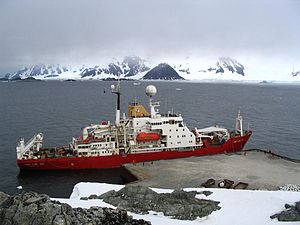Noosfera (icebreaker)
Appearance
 RRS James Clark Ross at Rothera wharf
| |
| History | |
|---|---|
| Name | James Clark Ross |
| Namesake | James Clark Ross |
| Operator | British Antarctic Survey |
| Builder | Swan Hunter, Wallsend, Tyne and Wear, United Kingdom |
| Launched | 1 December 1990 by Her Majesty Queen Elizabeth II |
| Homeport | Stanley, Falkland Islands |
| Identification |
|
| Fate | In service |
| Notes | [1][2][3] |
| General characteristics | |
| Type | Research vessel |
| Tonnage | 5,732 GT |
| Displacement | 7,767 tonnes (loaded) |
| Length | 99.04 m |
| Beam | 18.85 m |
| Draught | 6.30 m |
| Propulsion |
|
| Speed | 12 knots (22 km/h; 14 mph) |
| Endurance | 57 days |
| Capacity |
|
| Complement | 11 Officers and 15 Crew and up to 50 Scientific Personnel |
RRS James Clark Ross is a supply and research ship operated by the British Antarctic Survey.
History
RRS James Clark Ross is named after the British explorer James Clark Ross.[4] She replaced the RRS John Biscoe in 1991.
In March 2018, RRS James Clark Ross was due to sample the marine life around the world's biggest iceberg, A-68, but was unable to reach the site due to thick sea ice in the Weddell Sea.[5]
See also
- RRS Ernest Shackleton, another British Antarctic Survey Royal Research Ship.
- RRS Sir David Attenborough, a new Royal Research Ship planned to enter service in 2019.
- James Ross Island
Gallery
-
James Clark Ross outward bound from Portsmouth Naval Base 1 September 2010.
Footnotes
- ^ "Technical Data - RRS James Clark Ross". British Antarctic Survey. Archived from the original on 6 September 2007. Retrieved 20 August 2007.
- ^ "BAS Public Information Leaflet - Ships". British Antarctic Survey. Retrieved 24 November 2007.
- ^ Mike Gloistein. "RRS James Clark Ross". Archived from the original on 6 April 2008. Retrieved 24 November 2007.
- ^ "RRS James Clark Ross". British Antarctic Survey. Retrieved 24 November 2007.
- ^ Jonathan Amos (2 March 2018). "Mission to giant A-68 berg thwarted by sea-ice". BBC News. Retrieved 12 April 2018.
External links
- Ship's current position at British Antarctic Survey

